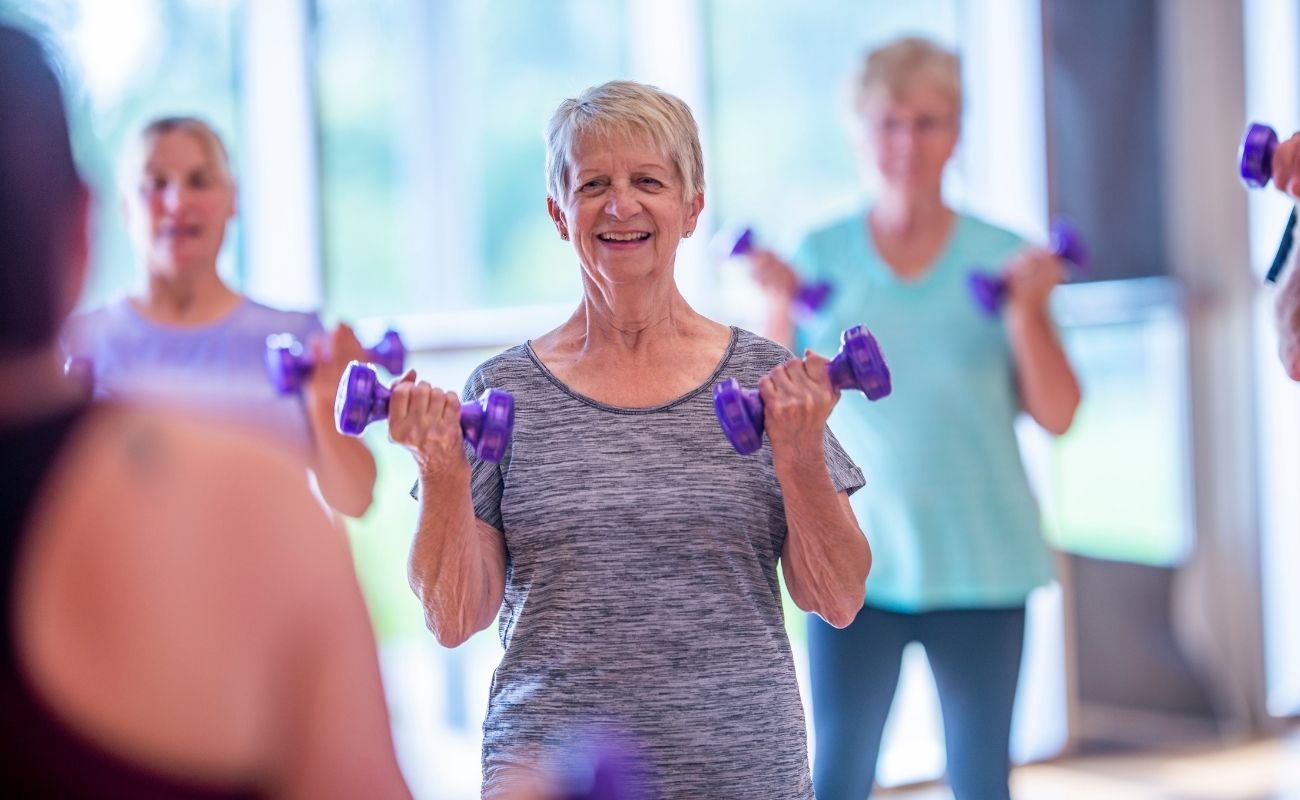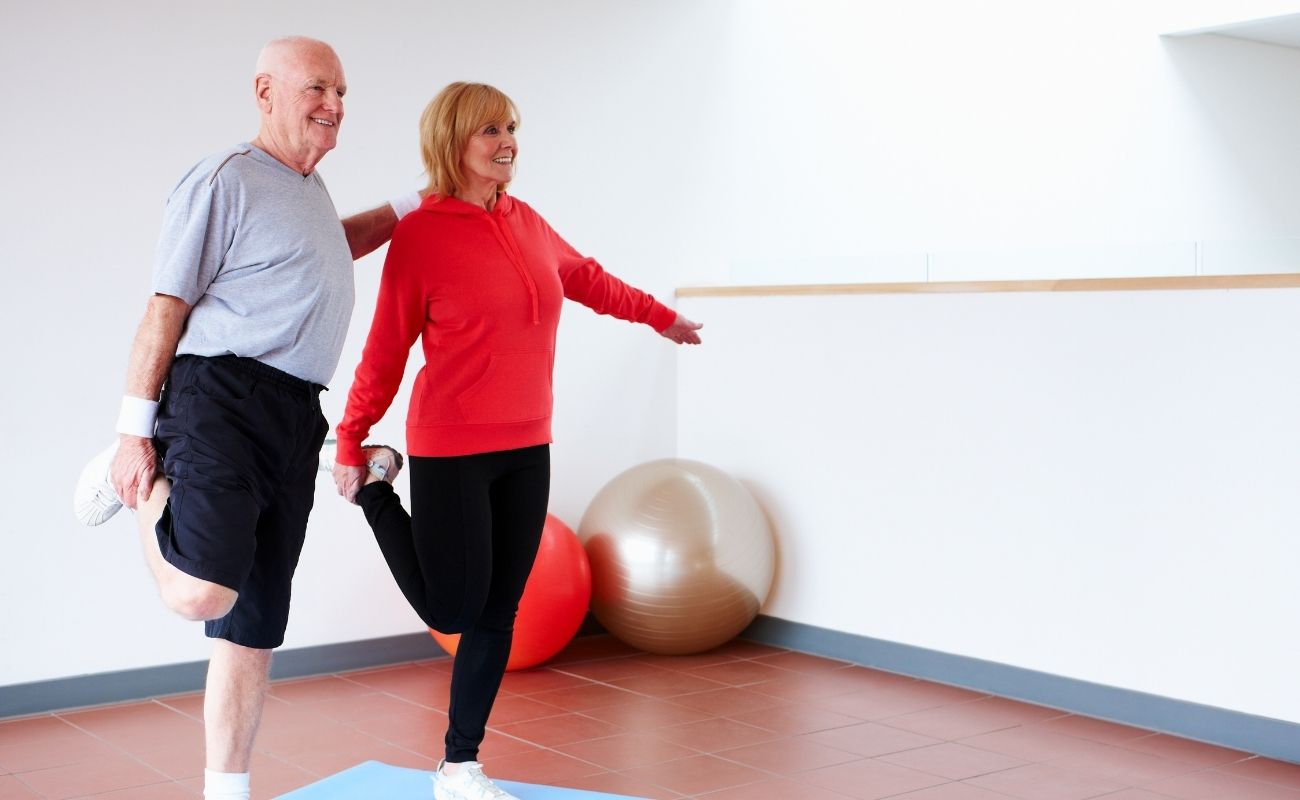


Every stage of life brings new opportunities for growth, health, and fulfillment. Living well isn’t just about adding years to your life, it’s about adding life to your years.

Every stage of life brings new opportunities for growth, health, and fulfillment. Living well isn’t just about adding years to your life, it’s about adding life to your years.
Build your foundation for successful aging through proven methods and hands-on guidance tailored to your needs.
Our comprehensive approach addresses the physical, mental, and social aspects of aging well, providing you with research-backed strategies that adapt to your unique circumstances and health goals.
Fuel your body with the right nutrients to support healthy aging, maintain energy levels, and prevent age-related health conditions.
Stay active and strong with age-appropriate fitness routines designed to improve balance, flexibility, strength, and cardiovascular health.
Quality sleep becomes increasingly important as we age. Understand the connection between rest, recovery, and overall well-being in your golden years.
Take charge of your health with proactive care strategies including regular screenings, vaccinations, medication management, and early intervention approaches.
Fuel your body with the right nutrients to support healthy aging, maintain energy levels, and prevent age-related health conditions.
Stay active and strong with age-appropriate fitness routines designed to improve balance, flexibility, strength, and cardiovascular health.
Quality sleep becomes increasingly important as we age. Understand the connection between rest, recovery, and overall well-being in your golden years.
Take charge of your health with proactive care strategies including regular screenings, vaccinations, medication management, and early intervention approaches.
Living well as a senior means making informed choices that support your physical health, mental wellbeing, and quality of life. Every day presents new opportunities to nurture your body, mind, and spirit through simple yet powerful practices. This comprehensive guide provides you with evidence-based strategies to help you thrive at any age.

Good nutrition forms the foundation of healthy aging. Your nutritional needs may change as you age, but the principles of eating well remain consistent: focus on whole foods, adequate protein, and proper hydration.
Create balanced meals by filling half your plate with colorful vegetables and fruits, one quarter with lean protein, and one quarter with whole grains. This approach provides the nutrients your body needs while supporting energy levels throughout the day.
As you age, your body needs more protein to maintain muscle mass and strength. Research from the PROT-AGE study group recommends that older adults consume at least 1.0 to 1.2 g/kg body weight daily to maintain and regain lean body mass and function.
Include protein sources at every meal, such as lean meats, fish, eggs, beans, nuts, and dairy products. Studies suggest that plant protein intake may be particularly beneficial for healthy aging. Aim for 25-30 grams of protein per meal to support muscle health.
These nutrients work together to maintain bone health. Include dairy products, leafy greens, and fortified foods in your daily routine. Speak with your healthcare provider about supplements if needed.
Dehydration becomes more common with age. Keep a water bottle nearby and sip throughout the day. Include water-rich foods like soups, fruits, and vegetables to boost your fluid intake.
Planning ahead makes healthy eating easier and more affordable. Prepare larger portions of your favorite healthy meals and freeze individual servings for busy days. Keep nutritious snacks like nuts, yogurt, and fresh fruit readily available.
Consider batch cooking on weekends when you have more time and energy. Prepare ingredients in advance by washing and chopping vegetables, cooking grains, or portioning proteins.
Many seniors face unique obstacles that can interfere with healthy eating habits. Understanding these challenges and having practical solutions ready can help you maintain good nutrition despite any difficulties you may encounter.
Small, frequent meals can be more appealing than three large ones. Focus on nutrient-dense foods that pack more nutrition into smaller portions.
Some medications affect appetite or nutrient absorption. Discuss any concerns with your pharmacist or healthcare provider.
Frozen fruits and vegetables offer the same nutritional value as fresh options and often cost less. Buy seasonal produce when prices are lower, and consider joining community programs that provide fresh foods to seniors.

Regular physical activity is one of the most powerful tools for healthy aging. Exercise improves balance, strength, flexibility, and mood while reducing the risk of chronic diseases. The World Health Organization recommends that older adults engage in at least 150 minutes of moderate-intensity aerobic activity weekly, plus muscle-strengthening activities on two or more days.
Research consistently shows that physical activity programs significantly improve balance, reduce fall risk, and enhance overall physical function in older adults. The key is finding activities you enjoy and can maintain consistently.
A well-rounded exercise program addresses different aspects of physical health to keep you strong, balanced, and mobile. Each pillar plays a unique role in supporting your overall fitness and reducing age-related health risks.

Activities that increase your heart rate improve circulation, boost energy, and support heart health. Walking remains one of the best options for seniors. Start with 10-15 minutes daily and gradually increase duration. Swimming, dancing, and cycling are excellent alternatives.

Maintaining muscle mass becomes increasingly important as you age. Use resistance bands, light weights, or your own body weight to perform strength exercises twice weekly. Focus on major muscle groups including legs, arms, back, and core.

Falls are a serious concern for seniors, but balance exercises can significantly reduce this risk. Research shows that structured balance training programs can effectively improve balance performance and reduce fall risk in older adults. Practice standing on one foot, heel-to-toe walking, or tai chi movements. Many activities can be done while holding onto a chair or wall for support.

Regular stretching maintains range of motion and reduces stiffness. Gentle yoga, stretching routines, or simple movements while watching television can keep your joints mobile and comfortable.
Start slowly and listen to your body. Begin with activities you enjoy and gradually add new elements. Consistency matters more than intensity. The National Institute on Aging recommends following their four-type approach: endurance, strength, balance, and flexibility exercises to maintain independence longer. Aim for at least 150 minutes of moderate activity per week, broken into manageable sessions.
Start your day with gentle stretches or a short walk. Morning activity can boost energy and improve mood for the entire day.
Group exercise classes, walking clubs, or dancing provide social interaction along with physical benefits. Many community centers offer senior-friendly programs.
Create a simple routine you can do at home using resistance bands, light weights, or just your body weight. Online videos designed for seniors can guide you through safe, effective workouts.
Always warm up before exercising and cool down afterward. Wear appropriate footwear and clothing for your activities. Stay hydrated, especially during longer or more intense sessions.
If you have chronic conditions or haven’t exercised recently, consult your healthcare provider before starting a new routine. They can help you identify safe activities and any precautions you should take.

Quality sleep becomes even more important as you age, supporting memory, immune function, and overall health. Research indicates that between 40% and 70% of older adults experience chronic sleep issues, with up to half of cases going undiagnosed.
Studies have shown that stable sleep patterns are linked to successful aging outcomes. Many seniors experience changes in sleep patterns, but good sleep hygiene can help you achieve the restorative rest your body needs.
As you age, you may find yourself going to bed earlier and waking up earlier. You might also experience lighter sleep with more frequent awakenings. These changes are normal, but poor sleep quality is not something you have to accept.
Your bedroom environment plays a crucial role in determining the quality of your rest each night. Simple changes to your sleep space can make a significant difference in how well you sleep and how refreshed you feel in the morning.
Keep your bedroom cool, dark, and quiet. Use blackout curtains or an eye mask to block light. Consider a white noise machine or earplugs if noise is an issue.
Invest in a supportive mattress and pillows that align with your preferred sleep position. Replace bedding regularly to maintain comfort and cleanliness.
Remove televisions, computers, and phones from the bedroom. The blue light from screens can interfere with your body’s natural sleep signals.
Good sleep habits, also known as sleep hygiene, are practices that promote consistent, quality sleep night after night. These habits work by supporting your body’s natural sleep-wake cycle and creating conditions that favor restful sleep.
Go to bed and wake up at the same time each day, even on weekends. This helps regulate your body’s internal clock.
Create a relaxing pre-sleep routine that signals to your body that bedtime is approaching. This might include reading, gentle stretching, or listening to calming music.
Get exposure to natural light during the day, especially in the morning. Limit long naps, particularly late in the afternoon, as they can interfere with nighttime sleep.Create a relaxing pre-sleep routine that signals to your body that bedtime is approaching. This might include reading, gentle stretching, or listening to calming music.
Sleep interruptions become more common as we age, but they don’t have to rob you of quality rest. Research shows that as many as 50% of older adults report poor sleep quality, which can increase the risk of morbidity and mortality. Having strategies ready for common sleep disruptors can help you get back to sleep more quickly and maintain better overall sleep quality.
If pain keeps you awake, work with your healthcare provider to develop an effective pain management strategy. Gentle stretching or a warm bath before bed may help.
Keep a small nightlight in the bathroom to avoid turning on bright lights during nighttime visits. Limit fluid intake close to bedtime if frequent trips are disrupting your sleep.
Practice relaxation techniques such as deep breathing or progressive muscle relaxation. Keep a notepad by your bed to write down worries so you can address them the next day.
If sleep problems persist despite good sleep hygiene, consult your healthcare provider. Sleep disorders such as sleep apnea become more common with age and require professional treatment. Certain medications can also affect sleep quality.

Preventive care helps you maintain your health and catch potential problems early. Regular check-ups, screenings, and health monitoring are your best defense against serious health issues.
Routine health screenings are your first line of defense against serious health problems. These tests can detect issues before symptoms appear, allowing for earlier treatment and better health outcomes.
Schedule yearly visits with your primary care provider to monitor your overall health, review medications, and update preventive care plans.
Schedule yearly visits with your primary care provider to monitor your overall health, review medications, and update preventive care plans.
Discuss bone density testing with your healthcare provider, especially if you have risk factors for osteoporosis.
Continue age-appropriate cancer screenings as recommended by your healthcare team. These may include mammograms, colonoscopies, and skin examinations.
Proper medication management becomes increasingly important as you age and potentially take multiple medications. Safe and effective medication use requires organization, regular monitoring, and clear communication with your healthcare providers.
Regularly review all medications with your pharmacist or healthcare provider. This includes prescription drugs, over-the-counter medications, and supplements.
Use pill organizers, medication lists, or smartphone apps to keep track of your medications. Take medications as prescribed and at consistent times.
Be aware of potential side effects and drug interactions. Report any concerns to your healthcare provider promptly.
Tracking key health indicators at home helps you stay aware of changes in your condition and provides valuable information for your healthcare team. Simple monitoring tools can help you catch potential problems early and manage chronic conditions more effectively.
If you have hypertension or are at risk, consider monitoring your blood pressure at home. Keep a log to share with your healthcare provider.
Diabetics should monitor blood sugar as directed. Even if you don’t have diabetes, be aware of symptoms and risk factors.
Maintain a healthy weight through proper nutrition and regular physical activity. Sudden weight changes should be discussed with your healthcare provider.
A strong healthcare team provides comprehensive support for all aspects of your wellbeing. Having the right professionals in place and maintaining good communication between them helps coordinate your care and address health concerns promptly.
Establish a relationship with a primary care doctor who understands your health history and coordinates your care.
Work with specialists as needed for specific health conditions. Maintain communication between all your healthcare providers.
Your pharmacist is a valuable resource for medication questions and can help identify potential drug interactions.
Include family members or friends in your healthcare decisions when appropriate. They can provide support and help you remember important information.
Your mental and emotional health are just as important as your physical health for overall wellbeing. Taking care of your mind through social connections, mental stimulation, and stress management can improve your quality of life and support healthy aging.
Maintain social relationships and engage in community activities. Loneliness and isolation can significantly impact both mental and physical health.
Keep your mind active through reading, puzzles, learning new skills, or engaging hobbies. Mental stimulation supports cognitive health.
Practice stress-reduction techniques such as meditation, deep breathing, or gentle exercise. Chronic stress can worsen many health conditions.
Don’t hesitate to seek professional help if you’re experiencing depression, anxiety, or other mental health concerns. These conditions are treatable and support is available.
Living well as a senior is about making daily choices that support your health and happiness. Small, consistent changes in nutrition, exercise, sleep, and preventive care can lead to significant improvements in your quality of life.
Remember that everyone’s journey is different. What works for one person may need to be adapted for another. Work with your healthcare team to develop strategies that fit your individual needs, preferences, and circumstances.
The goal is not perfection but progress. Celebrate small victories and be patient with yourself as you develop new habits. Each positive choice you make is an investment in your health and future wellbeing.
Start with one area that interests you most, and gradually incorporate other elements as they become routine. Your efforts today will pay dividends in increased energy, better health, and greater enjoyment of life in the years to come.
To learn more about the topics covered in this guide, here are valuable research sources and organizations:
Living well as a senior means making informed choices that support your physical health, mental wellbeing, and quality of life. Every day presents new opportunities to nurture your body, mind, and spirit through simple yet powerful practices.
This comprehensive guide provides you with evidence-based strategies to help you thrive at any age.

Good nutrition forms the foundation of healthy aging. Your nutritional needs may change as you age, but the principles of eating well remain consistent: focus on whole foods, adequate protein, and proper hydration.
Create balanced meals by filling half your plate with colorful vegetables and fruits, one quarter with lean protein, and one quarter with whole grains. This approach provides the nutrients your body needs while supporting energy levels throughout the day.
As you age, your body needs more protein to maintain muscle mass and strength. Research from the PROT-AGE study group recommends that older adults consume at least 1.0 to 1.2 g/kg body weight daily to maintain and regain lean body mass and function.
Include protein sources at every meal, such as lean meats, fish, eggs, beans, nuts, and dairy products. Studies suggest that plant protein intake may be particularly beneficial for healthy aging. Aim for 25-30 grams of protein per meal to support muscle health.
These nutrients work together to maintain bone health. Include dairy products, leafy greens, and fortified foods in your daily routine. Speak with your healthcare provider about supplements if needed.
Dehydration becomes more common with age. Keep a water bottle nearby and sip throughout the day. Include water-rich foods like soups, fruits, and vegetables to boost your fluid intake.
Planning ahead makes healthy eating easier and more affordable. Prepare larger portions of your favorite healthy meals and freeze individual servings for busy days. Keep nutritious snacks like nuts, yogurt, and fresh fruit readily available.
Consider batch cooking on weekends when you have more time and energy. Prepare ingredients in advance by washing and chopping vegetables, cooking grains, or portioning proteins.
Many seniors face unique obstacles that can interfere with healthy eating habits. Understanding these challenges and having practical solutions ready can help you maintain good nutrition despite any difficulties you may encounter.
Small, frequent meals can be more appealing than three large ones. Focus on nutrient-dense foods that pack more nutrition into smaller portions.
Some medications affect appetite or nutrient absorption. Discuss any concerns with your pharmacist or healthcare provider.
Frozen fruits and vegetables offer the same nutritional value as fresh options and often cost less. Buy seasonal produce when prices are lower, and consider joining community programs that provide fresh foods to seniors.

Regular physical activity is one of the most powerful tools for healthy aging. Exercise improves balance, strength, flexibility, and mood while reducing the risk of chronic diseases.
The World Health Organization recommends that older adults engage in at least 150 minutes of moderate-intensity aerobic activity weekly, plus muscle-strengthening activities on two or more days.
Research consistently shows that physical activity programs significantly improve balance, reduce fall risk, and enhance overall physical function in older adults. The key is finding activities you enjoy and can maintain consistently.
A well-rounded exercise program addresses different aspects of physical health to keep you strong, balanced, and mobile. Each pillar plays a unique role in supporting your overall fitness and reducing age-related health risks.

Activities that increase your heart rate improve circulation, boost energy, and support heart health. Walking remains one of the best options for seniors. Start with 10-15 minutes daily and gradually increase duration. Swimming, dancing, and cycling are excellent alternatives.

Maintaining muscle mass becomes increasingly important as you age. Use resistance bands, light weights, or your own body weight to perform strength exercises twice weekly. Focus on major muscle groups including legs, arms, back, and core.

Falls are a serious concern for seniors, but balance exercises can significantly reduce this risk. Research shows that structured balance training programs can effectively improve balance performance and reduce fall risk in older adults. Practice standing on one foot, heel-to-toe walking, or tai chi movements. Many activities can be done while holding onto a chair or wall for support.

Regular stretching maintains range of motion and reduces stiffness. Gentle yoga, stretching routines, or simple movements while watching television can keep your joints mobile and comfortable.
Start slowly and listen to your body. Begin with activities you enjoy and gradually add new elements. Consistency matters more than intensity.
The National Institute on Aging recommends following their four-type approach: endurance, strength, balance, and flexibility exercises to maintain independence longer. Aim for at least 150 minutes of moderate activity per week, broken into manageable sessions.
Start your day with gentle stretches or a short walk. Morning activity can boost energy and improve mood for the entire day.
Group exercise classes, walking clubs, or dancing provide social interaction along with physical benefits. Many community centers offer senior-friendly programs.
Create a simple routine you can do at home using resistance bands, light weights, or just your body weight. Online videos designed for seniors can guide you through safe, effective workouts.
Always warm up before exercising and cool down afterward. Wear appropriate footwear and clothing for your activities. Stay hydrated, especially during longer or more intense sessions.
If you have chronic conditions or haven’t exercised recently, consult your healthcare provider before starting a new routine. They can help you identify safe activities and any precautions you should take.

Quality sleep becomes even more important as you age, supporting memory, immune function, and overall health. Research indicates that between 40% and 70% of older adults experience chronic sleep issues, with up to half of cases going undiagnosed.
Studies have shown that stable sleep patterns are linked to successful aging outcomes. Many seniors experience changes in sleep patterns, but good sleep hygiene can help you achieve the restorative rest your body needs.
As you age, you may find yourself going to bed earlier and waking up earlier. You might also experience lighter sleep with more frequent awakenings. These changes are normal, but poor sleep quality is not something you have to accept.
Your bedroom environment plays a crucial role in determining the quality of your rest each night. Simple changes to your sleep space can make a significant difference in how well you sleep and how refreshed you feel in the morning.
Keep your bedroom cool, dark, and quiet. Use blackout curtains or an eye mask to block light. Consider a white noise machine or earplugs if noise is an issue.
Invest in a supportive mattress and pillows that align with your preferred sleep position. Replace bedding regularly to maintain comfort and cleanliness.
Remove televisions, computers, and phones from the bedroom. The blue light from screens can interfere with your body’s natural sleep signals.
Good sleep habits, also known as sleep hygiene, are practices that promote consistent, quality sleep night after night. These habits work by supporting your body’s natural sleep-wake cycle and creating conditions that favor restful sleep.
Go to bed and wake up at the same time each day, even on weekends. This helps regulate your body’s internal clock.
Create a relaxing pre-sleep routine that signals to your body that bedtime is approaching. This might include reading, gentle stretching, or listening to calming music.
Get exposure to natural light during the day, especially in the morning. Limit long naps, particularly late in the afternoon, as they can interfere with nighttime sleep.
Create a relaxing pre-sleep routine that signals to your body that bedtime is approaching. This might include reading, gentle stretching, or listening to calming music.
Sleep interruptions become more common as we age, but they don’t have to rob you of quality rest. Research shows that as many as 50% of older adults report poor sleep quality, which can increase the risk of morbidity and mortality.
Having strategies ready for common sleep disruptors can help you get back to sleep more quickly and maintain better overall sleep quality.
If pain keeps you awake, work with your healthcare provider to develop an effective pain management strategy. Gentle stretching or a warm bath before bed may help.
Keep a small nightlight in the bathroom to avoid turning on bright lights during nighttime visits. Limit fluid intake close to bedtime if frequent trips are disrupting your sleep.
Practice relaxation techniques such as deep breathing or progressive muscle relaxation. Keep a notepad by your bed to write down worries so you can address them the next day.
If sleep problems persist despite good sleep hygiene, consult your healthcare provider. Sleep disorders such as sleep apnea become more common with age and require professional treatment. Certain medications can also affect sleep quality.

Preventive care helps you maintain your health and catch potential problems early. Regular check-ups, screenings, and health monitoring are your best defense against serious health issues.
Routine health screenings are your first line of defense against serious health problems. These tests can detect issues before symptoms appear, allowing for earlier treatment and better health outcomes.
Schedule yearly visits with your primary care provider to monitor your overall health, review medications, and update preventive care plans.
Schedule yearly visits with your primary care provider to monitor your overall health, review medications, and update preventive care plans.
Discuss bone density testing with your healthcare provider, especially if you have risk factors for osteoporosis.
Continue age-appropriate cancer screenings as recommended by your healthcare team. These may include mammograms, colonoscopies, and skin examinations.
Proper medication management becomes increasingly important as you age and potentially take multiple medications. Safe and effective medication use requires organization, regular monitoring, and clear communication with your healthcare providers.
Regularly review all medications with your pharmacist or healthcare provider. This includes prescription drugs, over-the-counter medications, and supplements.
Use pill organizers, medication lists, or smartphone apps to keep track of your medications. Take medications as prescribed and at consistent times.
Be aware of potential side effects and drug interactions. Report any concerns to your healthcare provider promptly.
Tracking key health indicators at home helps you stay aware of changes in your condition and provides valuable information for your healthcare team. Simple monitoring tools can help you catch potential problems early and manage chronic conditions more effectively.
If you have hypertension or are at risk, consider monitoring your blood pressure at home. Keep a log to share with your healthcare provider.
Diabetics should monitor blood sugar as directed. Even if you don’t have diabetes, be aware of symptoms and risk factors.
Maintain a healthy weight through proper nutrition and regular physical activity. Sudden weight changes should be discussed with your healthcare provider.
A strong healthcare team provides comprehensive support for all aspects of your wellbeing. Having the right professionals in place and maintaining good communication between them helps coordinate your care and address health concerns promptly.
Establish a relationship with a primary care doctor who understands your health history and coordinates your care.
Work with specialists as needed for specific health conditions. Maintain communication between all your healthcare providers.
Your pharmacist is a valuable resource for medication questions and can help identify potential drug interactions.
Include family members or friends in your healthcare decisions when appropriate. They can provide support and help you remember important information.
Your mental and emotional health are just as important as your physical health for overall wellbeing. Taking care of your mind through social connections, mental stimulation, and stress management can improve your quality of life and support healthy aging.
Maintain social relationships and engage in community activities. Loneliness and isolation can significantly impact both mental and physical health.
Keep your mind active through reading, puzzles, learning new skills, or engaging hobbies. Mental stimulation supports cognitive health.
Practice stress-reduction techniques such as meditation, deep breathing, or gentle exercise. Chronic stress can worsen many health conditions.
Don’t hesitate to seek professional help if you’re experiencing depression, anxiety, or other mental health concerns. These conditions are treatable and support is available.
Living well as a senior is about making daily choices that support your health and happiness. Small, consistent changes in nutrition, exercise, sleep, and preventive care can lead to significant improvements in your quality of life.
Remember that everyone’s journey is different. What works for one person may need to be adapted for another. Work with your healthcare team to develop strategies that fit your individual needs, preferences, and circumstances.
The goal is not perfection but progress. Celebrate small victories and be patient with yourself as you develop new habits. Each positive choice you make is an investment in your health and future wellbeing.
Start with one area that interests you most, and gradually incorporate other elements as they become routine. Your efforts today will pay dividends in increased energy, better health, and greater enjoyment of life in the years to come.
To learn more about the topics covered in this guide, here are valuable research sources and organizations: